|
|
Priam

|
|
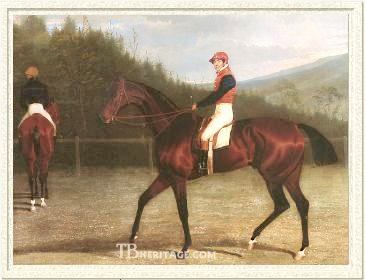 |
|
|
Priam was an outstanding race horse, winner of two classics, who could beat horses at any distance. He was so powerful on the turf that many of his ardent supporters compared him to the mighty Eclipse. He was his sire's first Derby winner, and proved to be his best son in the stud, based on earnings of winners, a leading sire multiple times on both sides of the Atlantic. Despite his success, he was unable to produce a son that could carry the sire line on in any significant way, or even one that came close to his impressive victories -- those laurels largely fell to his stellar daughters, and it is through his daughters that his name is seen in pedigrees today.
Priam was bred by Sir John Shelley (owner of Derby winner Phantom and his Derby-winning son, Cedric) at his farm in Sussex. His dam, Cressida (1807), was out of Young Giantess, who was by Whiskey. Cressida's sister was the great race mare Eleanor, winner of the Oaks, and a number of cups and plates during her long career, and later dam of the good racehorse and sire, Muley, by Orville. Her half-brother was the good racehorse and influential sire, Sorcerer (by Diomed). Her outstanding dam, Young Giantess, also produced a filly to Walton, who became the dam of Langar, a good race horse and grandsire, through his flying daughter Vulture, of Orlando. In addition to Priam, Cressida bred the 1819 Two Thousand Guineas winner Antar (by Haphazard). Priam, heir to this wealth of running blood, was Cressida's tenth foal, born in 1827. She produced one more youngster, in 1828, and after some barren years, died on August 14, 1834.
|
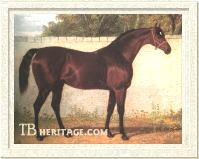
Emilius
| |
His sire, Emilius was undefeated in his first season on the turf; his wins included the Riddlesworth Stakes, the Derby Stakes, and the Grand Duke Michael Stakes that year. He was by the great four-miler Orville, who was later twice leading sire in Great Britain. Emilius' dam, Emily, ran distance races against top class horses. When Emilius retired from the turf, he was sold by his owner-breeder, Colonel John Udney, to Thomas Thornhill for 1800 guineas, and was retired to Thornhill's stud at Riddlesworth, Norfolk.
|
He became the most fashionable sire of the late 1820s and 1830s, with eight classic winners to his credit, which helped propel him to the top of the sire's list in Great Britain twice. Despite siring some excellent running sons, including some who got classic winners, it was mostly his daughters and the daughters of his sons that had a lasting influence on the breed.
Shelley offered Priam to Lord Jersey as a yearling, but Jersey, looking at his straight hind legs and thinking he was a likely candidate for later ringbone, and probably at his front legs, which were tied-in below the knee, refused the purchase. So Shelley sent Priam and other yearlings from his stud to public auction at Newmarket. There, the dark bay colt, somewhat leggy, with a refined head, beautifully-angled shoulder, and overall "feminine-looking" appearance caught the eye of jockey Sam Chifney, Jr., who determined to buy him. Despite his legs, the bidding accelerated to 1,000 guineas before he was knocked down to Chifney, his brother, trainer William Chifney, and trainer Montgomery Dilly (who had trained Emilus son Mango for his St. Leger win).
Priam, who eventually reached 15.2 hands, was sent to Sam Day for schooling. He was immature at age two, and was not started in races until age three.
Priam on the Turf
Priam proved to be a great weight carrier who could win at any distance. He won seven of his eight races in his first season, including the Derby. He was unbeaten at age four, and won three of his four starts at age five.
Will Chifney sent Priam out for his first race, the Riddlesworth Stakes, at Newmarket Craven, which he won, beating Mahmoud and four others. At the same meeting he won the Column Stakes, beating future 2,000 Guineas winner Augustus and five others. He also took a walk-over in a £450 sweep at that meeting. At Epsom he won the Derby by two lengths, beating 23 horses in a rain shower, and mastering thirteen false starts for the race. At Ascot he won a sweep, beating two others easily. He met his first defeat in the heavy going of the St. Leger at Doncaster, losing by half a length to the good stayer Birmingham, when Sam Chifney failed to bring him up from behind to catch the winner. A few days later Priam won a 500 sovereign match over 1-1/2 miles against Retriever, who won the Doncaster Gold Cup that day. He then walked over for the Gascoigne Stakes.
The next year he won every race he entered. He started by winning Newmarket's Craven Stakes and Port Stakes, after which he was sold to George Stanhope, (6th) Earl of Chesterfield for 3,000 guineas, for whom he won two matches, against the Ascot Gold Cup winner Lucetta and the good colt Augustus (to whom he conceded 16 pounds), and the Goodwood Cup.
At age five Priam won three of his four races, and paid forfeit for two in which he did not start: his wins were the King's Guineas at Newmarket, the Eclipse Foot and a sweepstakes at Ascot over 2-1/2 miles, and the Goodwood Cup, beating an excellent field to which he had given weight; his loss was a third in the Craven Stakes at the beginning of the season.
|
Priam in the Stud
Priam retired to stud at Chesterfield's Bretby Park, where his initial fee was 30 sovereigns, later rising to 40. He was in England for four years, and was leading sire twice, in 1839 and 1840, after he had been exported to the U.S.
In the spring of 1836, James Jackson of Alabama had enquired of Edmund Tattersall, the principal bloodstock agent for Americans looking to buy in England, whether either Plenipotentiary or Priam, both by Emilius, were available for purchase, and Tattersall replied that neither were "to be had for money." Jackson had to content himself with purchasing Glencoe, to the everlasting benefit of American breeding. However, Chesterfield was deeply in debt, and when the next offer, of $15,000, came soon after, Priam was sold to Richard Tattersall on behalf of Dr. A.T.B. Merritt of Virginia, whose company was responsible for importing, on speculation, a number of high-class horses in the 1830s. He arrived in the U.S. in 1837 and was installed at Merritt's Hicks Ford stud in Virginia. He was later sold to Tennessee breeder Leonard Cheatham (who owned imported Merman), who stood him at his own stud at Robertson's Bend in 1842 for a fee of $150, and then sent him to stand at General Harding's Belle Meade Stud in Tennessee, where he remained until his death in 1847.
In England, Priam left CRUCIFIX (1837, out of Octaviana by Octavian), the top filly of her generation; Oaks winner INDUSTRY (1835, out of Arachne by Filho-da-Puta), and the in-bred (to Orville) Oaks winner MISS LETTY (1834, out of an Orville mare). He left precious few good running sons in England, the best probably being DEY OF ALGIERS (1835, out of a Bustard mare), who won the Chester Cup in 1840.
He also left GIGES (1837, from Eva by Sultan), born in France, who, in 1841, won for the Duc d'Orleans the Grand Prix Royal Oak (later Prix Gladiateur) over 4,000 meters and several other races, and later got French Oaks winner Wirthschaft (1844, from Weeper, who won races at Newmarket, including the Clearwell Stakes, and was by Woful), and the in-bred Royal Quand-Meme (1850, from Eusebia (imported into France in 1844, by Emilius), winner of the Grand Prix Imperial (another name for Prix Gladiateur), among other races in 1854, making him the most successful of older horses there that year.
In the U.S. Priam was wildly popular, with a reported 150 mares sent to him in his first season. He led the sire's lists four times, 1842, and 1844-46, and was second in 1843. Despite the production of numerous winners, it is only through his daughters he had any lasting influence, which, in a way, is what was intended when he was imported, since American breeders of the 1830s were desperate for outcrosses on their in-bred American mares. |
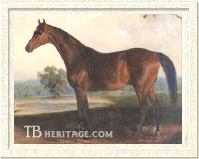
Monarch
| |
Priam did have a good son in America, the best of any of his sons, but he had been bred in England by King William IV, and was purchased for $1,280 as a yearling at the annual Hampton Court sale by Wade Hampton II of South Carolina. He was out the Whisker mare, Delphine, whom Hampton later purchased, in foal to Plenipotentiary, and had shipped to South Carolina. The yearling was MONARCH, and he was an unbeaten racehorse in the U.S., winning races at two, three and four miles, including the Jockey Club Purse at Charleston. He injured himself during a workout at age four, which ended his career. |
Monarch had a long, successful run as a sire, first at Hampton's Millwood stud, and then in Ohio, where his purchasers, Reber and Kutz (one-time owners of Bonnie Scotland), had a large bloodstock operation. Hampton also bought Monarch's year-younger sister, THE QUEEN, when a yearling, and imported her, later selling her for $6,000, the then-record price for a two-year-old, to Merritt.
An American daughter of Priam, LUCY LONG, produced Red Eye, who was, after Lexington and Lecomte, Boston's greatest son, winner of 33 of his 43 races; he was avoided by breeders when at stud because of "questionable" blood on his dam's side, and, sold to Illinois just before the Civil War, he vanished from sight. But the fillies from a number of daughters bred on, and some good late nineteenth century racehorses desended tail-female from his daughters, such as American Derby winner Uncle Bob (1887) and Withers Stakes winner Crickmore (1878), who came from two full sisters by Priam (Family A10). Another Priam daughter, MARGARET WOOD (1840, out of Maria West, by Marion), produced the in-bred Heraldry (by Plenipotentiary's son, Herald), who was the principal conduit through which American Family A-1 descends.
Of Priam's other sons, the aforementioned GIGES (1837, from the Sultan mare Eva) was probably the best, both as a racehorse and a sire, and he did all that in France. In England, Priam's sons were only moderately successful, both on the turf and in the breeding shed. PRIZEFLOWER (1834), who was bred by Chesterfield, won at moderate venues, including the Park Stakes at Heaton Park. TROILUS (1834, from the Sultan daughter Green Mantle) won distance races, including the two mile Queen's Plate at Ipswich.
CHESTERFIELD (1834, out of Octaviana by Octavian), a sibling to his much better sister, CRUCIFIX, was bred by Lord Chesterfield. He got a fairly good racing son, The Hero (1843, from Grace Darling by Defence), bred by John Day at Danebury, and it briefly appeared the Priam line would continue through this grandson of his, who won the Doncaster Cup, the Goodwood Cup, the Queen's Vase at Ascot, and some other races. The Hero got Goodwood Cup winner Rogerthorpe (1853), but he was effectively the end of the male line for Priam.
Priam was a much better sire of fillies than of colts, and overall his daughters did far better on the turf than his sons. As with his sire, Emilius, it is almost exclusively through the female line that Priam is seen in pedigrees today.
|
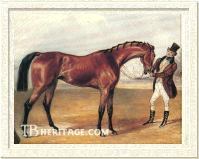
Miss Letty
| |
MISS LETTY (1834, Family 12 - g) was bred by Thomas Orde Powlett of Bolton Castle, near Middleham, Yorkshire. Her dam was by Orville, making Miss Letty in-bred 3 x 2 to that good stallion. Miss Letty had a relatively light racing career, but proved to be a high-class filly that could win up to 2 miles.
She ran unnamed in her first year, winning one of her three starts, a Produce sweepstakes at Doncaster, beating two other youngsters. She came out at age three in the two mile Claret Stakes, and although favored to win, she came in fourth in a field of seven.
|
Miss Letty went on to Epsom, where she won the Oaks, beating a field of twelve other high class field of fillies, running easily near the front and, when released about 300 yards from the post, shooting to the front "like an electric flash, winning, hard held, by three lengths." She followed this win by easily beating Capulet in a 1-1/4 mile race at York, but surprised her backers by losing the Filly Stakes (over the St. Leger course) at Doncaster to the Waverley filly, Yarico. Her last race was at Lincoln, where she ran two-mile heats in a Queen's purse for mares, beating Miss Eliza.
Retired to Powlett's stud, she produced a succession of winners of which her third foal, Weatherbit (1842, by Sheet Anchor), was her best. Sold to gambler John Gully, he was winner of Ascot's Welcome Stakes and some other races, and second in high class company in the Goodwood Cup, the Great Metropolitan Stakes, and the Craven Stakes, the first two over two miles in distance. He sired Derby winner Beadsman, Doncaster Cup winer Mandrake, Cesarewitch winner Weathergage, Cambridgeshire winner Weatherbound, and other good runners. Miss Letty's daughter, Wee Pet (1840), a sister to Weatherbit, had wins that included the Leamington Stakes in 1845, and a second to The Baron in the Cesarewitch that same year. Several of Miss Letty's daughters bred on, with stakes winners well into the late 20th century. Miss Letty died in 1851.
|

Industry
| |
INDUSTRY (1835), was out of the Filho-da-Puta mare Arachne (Family 2 -f); she was bred and raced by George Stanhope, (6th) Earl Chesterfield. She was a high-strung filly who won a number of races at age three, although she was the beneficiary of the ill-luck of the top fillies of her year in the Oaks, all of them falling sick prior to its running, and leaving the way clear for her to win by a length in a race full of bumping by inferior fillies. Her other wins included a sweepstakes at Ascot, a 500 guineas match at Goodwood against Romania and a produce sweep at Stockbridge. The next year she won a handicap sweepstakes at the Pottery Meeting, the Trial Stakes at Wolverhampton, and the Cup Stakes at Burton-upon-Trent. Most of her races were at distances of two miles and under. |
|
Industry was a very successful producer, first for Lord Chesterfield, and later for Charles Greville. Her daughter Distaffina (1845) by Don John, won the Gratwicke Produce Stakes, and her full sister, Lady Evelyn (1846) won the Oaks, the Park Hill Stakes and other good races. Lady Evelyn went on to found a good line of winners in tail-female descent. Another Industry daughter, Stitch (1842, by Hornsea) was also tail-female ancestress of good horses, including the great French filly, La Toucques (1860, by The Baron), and more recently Danzatore (1980, by Northern Dancer). Horses such as Fox Law, Highclere, Gone West, Round Table and Aureole descend tail-female from another Industry daughter, Barcelona (1848, by Don John). Industry's last foal was the bay Chevalier d' Industrie (1854, by Orlando), winner of Goodwood's Gratwicke Stakes and several other races, and second in some good races, such as the Chesterfield Stakes, the Bentinck Memorial, and the Epsom Cup; he later got some good runners, such as Friponnier. |
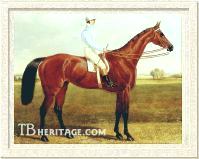
Crucifix
| |
CRUCIFIX (1837, Family 2 - i) was a lanky, ugly bay filly who came up for sale when George Stanhope (6th) Earl Chesterfield, had to sell his bloodstock to cover his many debts. She was at the foot of her twenty-one year old dam, Octaviana, who was by Octavian. Octaviana had produced a fairly good runner in her son, July Stakes winner Crusader, five years earlier. Crucifix and her dam were purchased by Lord George Bentinck for 54 guineas. Crucifix turned out to be Bentinck's best purchase ever, an outstanding juvenile and a multiple classic winner, and later produced a classic winner herself.
|
She was Priam's most brilliant offspring, and one whose potential may never have been fully realized, at least by the standards of those days, when few youngsters were faced the kinds of demands her connections made of her.
Crucifix was placed in the less than tender hands of trainer John Day, and being a somewhat uneven mover who tended to cross her legs when running, she was always raced in wraps. She won eight of her nine races as a juvenile, and a record £4,587 that first season. Her wins were Newmarket's July Stakes, the Chesterfield Stakes (carrying 9 pounds more than any other runner), Goodwood's Lavant Stakes and Molecombe Stakes, the Hopeful Stakes (Newmarket), the Clearwell Stakes, the Prendergast Stakes, and a walk-over in a sweepstakes at Newmarket October; the ninth race was a dead-heat for the Criterion Stakes with Gibraltar, where the owners divided the stakes rather than take a run-off.
At age three she came out three times. She won the Two Thousand Guineas, beating Confderate and Clearwell and three others by a length, and proceeded on to easily beat the few fillies that came up against her in the One Thousand Guineas. She entered her last race, the Oaks, with her failing legs a well-kept secret; there was little betting action because she was considered a sure winner. It took fourteen or fifteen starts to get the fifteen runners off cleanly, and Crucifix barely won, by one-half a length. The filly that ran second to her was another Priam daughter, WELFARE (1837, from Vat, by Langar, Family 1- o), who later won the Ascot Stakes. Another filly in this race was Pocahontas, who was to gain lasting fame in the breeding shed. The Oaks was Crucifix's last race, from which she emerged obviously lame, "sacrificed ere she has reached the zenith of her age, by premature abuse of her great powers."
Retired to Bentinck's stud in June, she did not produce her first foal, Cowl, until 1842. Then came Crozier (1844, by Lanercost), Surplice (1845, by Touchstone), and the short-lived Cucullus (1846, by Bay Middleton). Bentinck sold all his bloodstock, numbering at least 60 animals, to Edward-Lloyd Mostyn for the incredibly low sum of £10,000, including Crucifix -- for whom she bred the Touchstone colt, Pontifex (1847) -- and the yearling Surplice. Crucifix, and some of the other Bentinck stock were sold on to Henry Agar-Ellis (3rd) Viscount Clifden, and she bred four more youngsters for him, dying in 1857. She was buried at the Days' stables, Danebury.
Her best runner was Surplice, who, for Mostyn, easily won the Ham Produce Stakes and the Produce Stakes at Goodwood, and the Municipal Stakes at Doncaster, also receiving a forfeit in the Buckenham Stakes in the fall, consequently an undefeated juvenile winner, like his dam. He was sold to Clifden after this, and started in his colors for the Derby, his first race at age three, which he won by a neck in a fierce contest in its closing yards with Springy Jack, a Hetman Platoff son. His other wins that year included the St. Leger, making him the first horse to win both races since Champion had done so in 1800, the Grand Duke Michael Stakes, and walk-overs for the North of England Produce Stakes at Doncaster, and a £1000 sweepstakes at Newmarket Second October. He later got some good daughters, and was broodmare sire of the good race mare and top producer, Queen Bertha.
Of Crucifix's other offspring, most were good runners, and Cowl was later a moderately successful sire and is seen in the pedigree of Hermit. Her daughter, Chalice (1852, by Orlando), won the Royal Hunt Cup, and in the stud became second dam of Oaks winner Placida. Crucifix's most influential offspring in the breeding shed was her daughter, Rosary (1849, by Touchstone), whose daughter Penance (1857, by The Flying Dutchman) is the conduit through which this successful and prolific branch of Family 2 descends. The French Derby winner and sire Ajax, the Cambridgeshire winner and great broodmare Double Life (dam of Precipitation and Persian Gulf), and a great many other good horses descend from Crucifix in tail-female.
Other Priam daughters also ran well. ILIONA (1837, out of a mare by Eaton, Family 10), won the Cesarewitch Handicap Stakes.
WELFARE (1837, out of Vat, by Langar, Family 1 - o), was bred in Ireland by Colonel Westenra. She ran second to Crucifix in the Oaks, and at age four won the Ascot Stakes. In the stud her best was her bay daughter, The Deformed (1850, by Harkaway), winner of the Anglesy Stakes and and the National Produce Stakes. The Deformed, also bred by Westenra, was sent to Hampton Court Paddocks, and there produced a filly, Bessie, by Orlando, who was purchased by Lord Howth, who sent her to Ireland, where she bred Irish Grand National winner, The Gift. Another daughter of Bessie, Eudora, won over fences and produced Moorside II, who won the Becher steeplechase at Liverpool and sired 1924 Grand National winner Master Robert. The Bessie branch of The Deformed's family churned out a series of good jumpers over succeeding generations, including 1940 Conyngham Cup winner Ballyhooley.
Another Priam daughter with an influence on jumpers was an unnamed one, out of an unknown mare who is at the head of the Half-Bred Family 7. This Priam mare was second dam of the good runner and Cesarewitch winner Mrs. Taft (1845, by Don John). New Owestry (by Knight of Kars), who won races on the flat and over fences, descended tail-female from her, and in the stud in Shropshire got a number of good hunters and steeplechasers, including the Grand National winning mare, Zoedone.
|
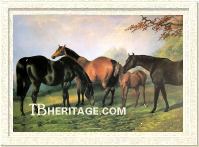
Left to Right: Annette, Polyxena and Polydora
| |
Priam sired other good producing daughters. ANNETTE (1835, out of a Don John mare) was born in Ireland, and never raced; after producing two foals, she was repurchased to England and passed through several owners, producing seventeen foals in 25 years. The most notable was Agnes, bred by trainer John Osborne, who was promising, but proved to be a roarer and was retired as a broodmare, establishing an enormously successful family that populates most of Family 16. Annette's other foals included Paladin (1843, by Clarion), a winner at Newmarket, and Nina (1848, by Cotherstone) a good juvenile that won Newmarket's Criterion Stakes.
|
Priam's daughter FAIR HELEN (1837, out of Partisan daughter, Dirce, Family 3 - m), produced Malton (1845, by Sheet Anchor), who won the Chester Cup, and, sent to France in the mid-1840s, produced Vermeille (1853, by The Baron), who became an excellent broodmare in France, dam of Vermout (Grand Prix de Paris and other wins), Vertugadin and Verite, the latter two winners in Germany, and some daughters that bred top winners in France.
JOANNINA (1835, from the Sultan mare Joanna, Family 1 - g) was a distance runner who later bred Epsom Derby winner The Cossack (1844, by Hetman Platoff). POLYXENA (1837, from a Cerebrus mare, Family 17 - a) produced Dacia (1845, by Gladiator), who won the 1845 Cambridgeshire; the good sires and French winners Eole and Negofol descended in tail-female from Dacia. POLYDORA (1837) became second dam of the good runner and sire St. Albans (1870, by Blair Athol).
CROPPY (1835, Family 5- b), produced a daughter to Lanercost in 1847, Kathleen, who became the dam of some excellent runners, including Cannisbrook, winner of the St. James's Palace Stakes and other top races; Sweet Kate, winner of the Preis der Diana (French Oaks), and Union Rennen winner Ignorant. A number of German classic winners and good sires were children or grandchildren of Sweet Kate in tail-female, including Flibustier and Amalie Von Edelreigh; another Cannisbrook daughter, La Traviata, was also the dam of top German racehorses.
--Patricia Erigero
|
|
|
|

